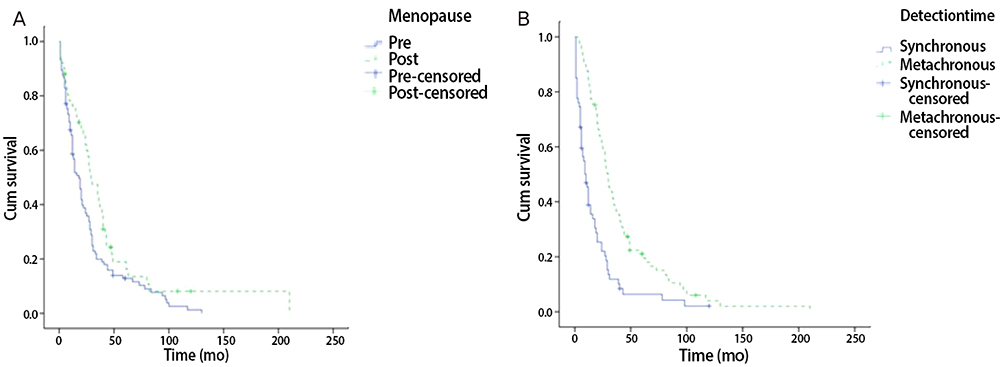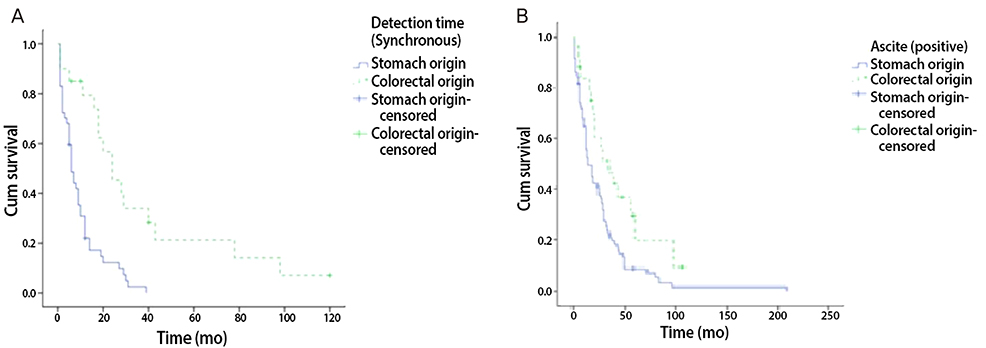Obstet Gynecol Sci.
2015 Jan;58(1):32-39. 10.5468/ogs.2015.58.1.32.
Krukenberg tumors of gastric origin versus colorectal origin
- Affiliations
-
- 1Department of Obstetrics and Gynecology, Kosin University Gospel Hospital, Kosin University College of Medicine, Busan, Korea. leehula@hanmail.net
- KMID: 1994224
- DOI: http://doi.org/10.5468/ogs.2015.58.1.32
Abstract
OBJECTIVE
The aim of this study is to compare the each clinical manifestation related with its mean survival time of Krukenberg tumors (KTs) of gastric origin versus with that of colorectal origin.
METHODS
A total of 156 consecutive patients diagnosed with KTs of the ovary who underwent surgical treatment at a single institution between 2001 and 2010 were retrospectively evaluated. Each clinical manifestation related with its mean survival time compared two different groups. Survival analyses and comparisons were performed using the Kaplan-Meier method.
RESULTS
Among the 156 patients with KT, 111 patients with KTs of gastric origin and 45 patients with KTs of colorectal origin were identified. For all patients with KTs, median survival time was 22.7 months. Each mean survival time among all patients with KTs of gastric origin and colorectal origin was 19.2 months and 27.3 months. The results showed that mean survival time of postmenopausal patients was 19.0 months compared with 32.5 months for premenopausal patients (P=0.015). Among all patients, mean survival time of those with metachronous cancer was longer than those with synchronous cancer (P=0.001). In all cases, especially when only one ovary was invaded, the mean survival time was relatively higher (P=0.001).
CONCLUSION
Patients with KTs of colorectal origin had a better prognosis than those of gastric origin. In all cases of KT, the mean survival time was significantly longer in postmenoposal patients, metachronous disease and unilateral ovarian involvement. Notably, synchronous, ascites positive, and ovary only metastasis showed more longer mean survival time in the KTs of colorectal origin than KTs of gastric origin.
MeSH Terms
Figure
Reference
-
1. Young RH. From Krukenberg to today: the ever present problems posed by metastatic tumors in the ovary. Part I: historical perspective, general principles, mucinous tumors including the Krukenberg tumor. Adv Anat Pathol. 2006; 13:205–227.2. Yada-Hashimoto N, Yamamoto T, Kamiura S, Seino H, Ohira H, Sawai K, et al. Metastatic ovarian tumors: a review of 64 cases. Gynecol Oncol. 2003; 89:314–317.3. Man M, Cazacu M, Oniu T. Krukenberg tumors of gastric origin versus Krukenberg tumors of colorectal origin. Chirurgia (Bucur). 2007; 102:407–410.4. McGill F, Ritter DB, Rickard C, Kaleya RN, Wadler S, Greston WM. Management of Krukenberg tumors: an 11-year experience and review of the literature. Prim Care Update Ob Gyns. 1998; 5:157–158.5. Serov SF, Scully RE. Histologic typing of ovarian tumors. Geneva: World Health Organization;1973. Vol. 9.6. Petru E, Pickel H, Heydarfadai M, Lahousen M, Haas J, Schaider H, et al. Nongenital cancers metastatic to the ovary. Gynecol Oncol. 1992; 44:83–86.7. Hale RW. Krukenberg tumor of the ovaries: a review of 81 records. Obstet Gynecol. 1968; 32:221–225.8. Webb MJ, Decker DG, Mussey E. Cancer metastatic to the ovary: factors influencing survival. Obstet Gynecol. 1975; 45:391–396.9. Moore RG, Chung M, Granai CO, Gajewski W, Steinhoff MM. Incidence of metastasis to the ovaries from nongenital tract primary tumors. Gynecol Oncol. 2004; 93:87–91.10. Park CH, Kim YH, Lee SK, Rew JH, Park JY, Hong SY, et al. Two cases of Krukenberg tumors. Korean J Gynecol Oncol Colposc. 1996; 7:68–75.11. Kiyokawa T, Young RH, Scully RE. Krukenberg tumors of the ovary: a clinicopathologic analysis of 120 cases with emphasis on their variable pathologic manifestations. Am J Surg Pathol. 2006; 30:277–299.12. Papakonstantinou E, Liapis A, Kairi-Vassilatou E, Iavazzo C, Kleanthis CK, Kondi-Pafiti A. Virilizing ovarian Krukenberg tumor in a 27-year-old pregnant woman: a case report and literature review. Eur J Gynaecol Oncol. 2011; 32:331–333.13. Yoo CH, Noh SH, Shin DW, Choi SH, Min JS. Recurrence following curative resection for gastric carcinoma. Br J Surg. 2000; 87:236–242.14. La Fianza A, Alberici E, Pistorio A, Generoso P. Differential diagnosis of Krukenberg tumors using multivariate analysis. Tumori. 2002; 88:284–287.15. Cheong JH, Hyung WJ, Chen J, Kim J, Choi SH, Noh SH. Survival benefit of metastasectomy for Krukenberg tumors from gastric cancer. Gynecol Oncol. 2004; 94:477–482.16. Al-Agha OM, Nicastri AD. An in-depth look at Krukenberg tumor: an overview. Arch Pathol Lab Med. 2006; 130:1725–1730.17. Kim WY, Kim TJ, Kim SE, Lee JW, Lee JH, Kim BG, et al. The role of cytoreductive surgery for non-genital tract metastatic tumors to the ovaries. Eur J Obstet Gynecol Reprod Biol. 2010; 149:97–101.18. Jiang R, Tang J, Cheng X, Zang RY. Surgical treatment for patients with different origins of Krukenberg tumors: outcomes and prognostic factors. Eur J Surg Oncol. 2009; 35:92–97.
- Full Text Links
- Actions
-
Cited
- CITED
-
- Close
- Share
- Similar articles
-
- Utility of Surgical Resection in the Management of Metachronous Krukenberg's Tumors of Gastric Origin
- A Case of The Krukenberg Tumor
- A Case of Krukenberg Tumor arising from Appendix
- Two Cases of Krukenberg Tumors
- Krukenberg Tumor Confirmed by Surgery during the Follow-up after a Primary Resection of Colorectal Cancer





